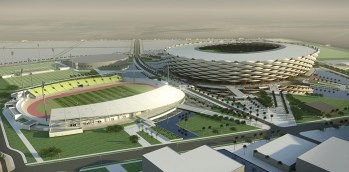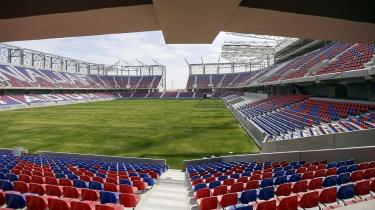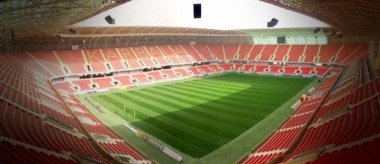Now that FIFA have finally lifted their ban on Iraq hosting international matches, both the Iraqi FA and Ministry of Youth and Sport have been keen on arranging several friendlies for their eager fans. Monday will see Iraq take on Palestine in yet another home game for Iraq, where the FA can showcase their ability to successfully welcome international teams on Iraqi soil.
The Basra Sports City stadium has been a major contributor to Iraq’s success in removing the international ban. With a huge 65,000 seat capacity, the Basra stadium has successfully hosted numerous matches, including Saudi Arabia and Syria. The unique design of the stadium has resulted in worldwide recognition of Iraq’s progress in developing its sports infrastructure. It includes an athletic running track and is an Olympic standard stadium. The primary stadium is integrated within a larger sports city that includes football training facilities, both indoors and outdoors. Likewise, there has been a focus on the building of international standard hotels in close proximity to the sports city, which will cater to visiting fans and teams. However, the $550 million spent on Basra Sports City is only one of many stadiums currently being developed.

Saturday will see the new Najaf Stadium unveiled following its recent completion. The 30,000 seater stadium will be presented to selected members of the media with aims of hosting competitive matches for the Iraqi national team. As of present, the FIFA ban removal only includes Basra, Karbala and Erbil. However, Baghdad and Najaf will be hoping to also be added to that list soon.

The cost of the Najaf stadium is expected to be around the region of $100 million dollars. Outside the stadium are a further two smaller stadiums. These will be used for youth games and training purposes. There has also been a focus on the building of hotels and restaurants adjacent to the new stadium, in order to profit from tourists looking to attend the football matches. Najaf also benefits from having a large international airport, making it a perfect hub for foreign teams and fans to visit the region. It also acts as a suitable destination for fans arriving for matches held in the Karbala Stadium.
Similarly to Najaf’s new stadium, nearby Karbala also received a 30,000 seat Olympic stadium at the cost of roughly $100 million. Karbala, known as one of the holiest cities for Shi’ite Muslims, already hosts a huge range of hotels and restaurants that offer high quality services that are close to the stadium. Al-Zawrra’a played their AFC Cup home game against Lebanese side, Al-Ahed, in Karbala’s Sports City stadium with overwhelming success, drawing in 17,000 fans in attendance.

These stadiums are a fantastic foundation for the future of Iraqi football, however, there still needs to be much more done in order to continue the progression of Iraq’s domestic league and national team. Regardless, it’s a huge step in the right direction for a country recovering from decades of turmoil. Over 450,000 jobs have been created by the Ministry of Youth and Sports, mostly for the country’s unemployed youth, which has been the direct result of the construction of these stadiums.
Whilst Karbala, Najaf and Basra have all enjoyed new stadiums, other areas have also benefited from the new development craze. Younis Mahmoud had the honours of kicking off the first ever match to be played in the Al-Kifl stadium, located in the Babel province. Fans were in ecstatic mood as they cheered on their 2007 Asian Cup captain as he walked onto the field. Although small in comparison to the other stadiums, with only 10,000 capacity, the stadium includes the latest in drainage and sprinkler systems to ensure a high-quality playing surface for the players. Likewise, it is anticipated that construction of further stadiums will also reach their completion stage soon.

Baghdad, which currently holds the Al-Shaab Stadium, will anticipate the compilation of the Ammo Baba Stadium later this year. With one large stadium, 31,000 in capacity, and two other smaller adjacent pitches, the sports complex will by one of two new stadiums being built in the capital. Saudi Arabia have also promised to build a new stadium for the Iraqi national team, as a token of gratitude, following the friendly that took place earlier in the year. Kut and Hilla are all expecting stadiums to be completed soon.
With such a large number of stadiums being built in the country, it is hoped that we will see the complete removal of the international football ban on Iraq. Abdul-Hussein Abtaan played a key role leading up to the FIFA decision to partially remove the ban by visiting neighboring countries and strengthening ties with foreign FAs. With their support, FIFA were forced to act under pressure and Iraq will be able to host their first international competitive match in nearly 30 years. Likewise, he also oversaw the construction of Karbala and Najaf’s Sports Cities. These steps have proven pivotal in starting a new chapter for Iraqi football. There is much that needs to be done, but this is certainly one huge step in the right direction and has put Iraq back on the footballing world map.



2 thoughts on “The Unveiling Of Najaf’s 30,000 Capacity Stadium To Signal A New Chapter For Iraqi Football”